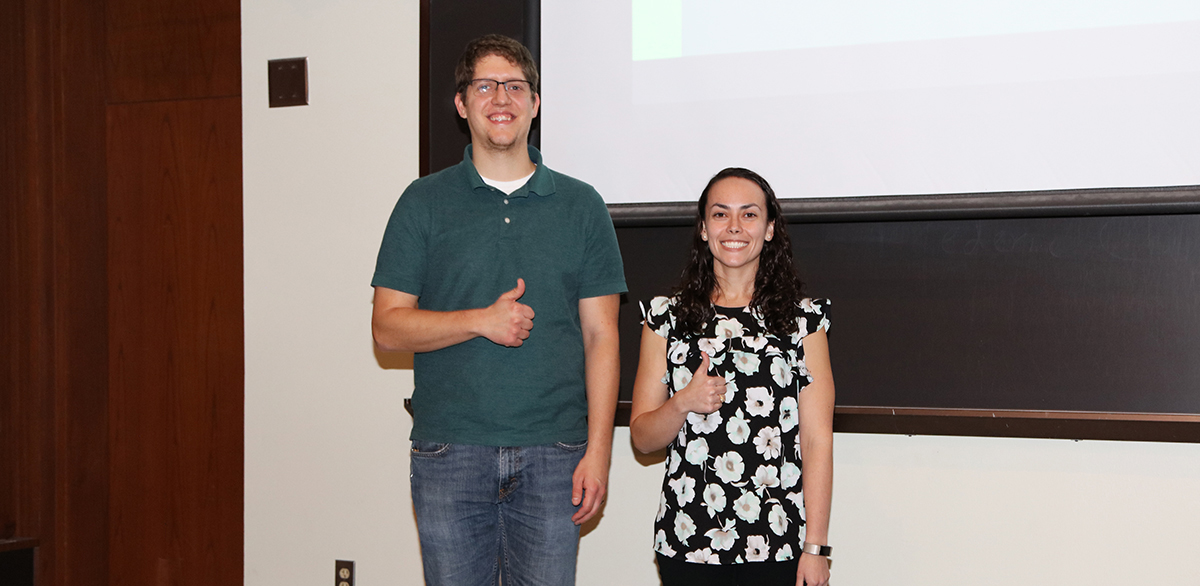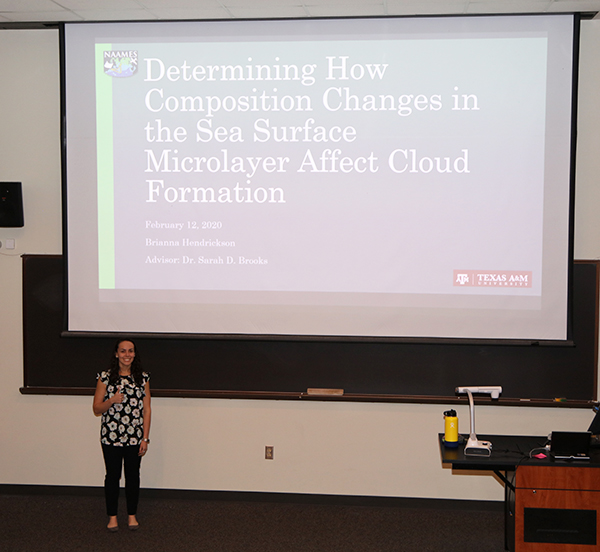Graduate Students Present Research At Special Atmospheric Sciences Seminar
Kyle Wodzicki and Brianna Hendrickson, winners of the Atmospheric Science Graduate Student Seminar Series, presented their research.
Feb 26, 2020

Each year, the Department of Atmospheric Sciences at Texas A&M University provides funding for a series of seminars presented by graduate students, for an audience of other graduate students. The purpose is for students to practice giving presentations to a peer audience, and the subject matter is open to any research the students are engaged in — either through funding, internships or personal interest. Most students choose to present their Master’s or Ph.D. research, and each presentation is given constructive feedback from the graduate student audience.
At the end of the semester the highest rated seminar speaker is awarded a $500 cash award for their work.
Each year’s winners are then invited to present their research to the entire department during its spring seminar series the following year. Kyle Wodzicki, the winner of the Spring 2019 series, and Brianna Hendrickson, winner of the Fall 2019 series, presented this year.


Kyle Wodzicki: Changes In Tropical Pacific Convection
Wodzicki, who works with Dr. Anita Rapp, presented his doctoral research concerning changes in convection in the tropical Pacific Ocean.
The Walker and Hadley cell circulations, the tropical components of the general atmospheric mean circulation, have been observed to have changed as a result of climate change, Wodzicki said. The Intertropical Convergence Zone (ITCZ), the meeting point between the Northern and Southern Hemispheric circulation cells, is strongly linked to tropical precipitation. Therefore, he said, identifying how tropical convection and cloud populations react to changes in the ITCZ is a key research area in identifying the impacts of climate change.
Wodzicki’s current research builds on his Master’s research, in which he built a database of ITCZ characteristics using an algorithm to identify the location of convergence regions in the tropical Pacific over the last 30 years. He was then able to compare that database with data collected from the Terra, Aqua, and TRMM satellites to quantify the magnitude and location of ITCZs and see how changes in those characteristics affect rainfall rates.
He found that tropical precipitation is less driven directly by the ITCZ and more by the El Niño Southern Oscillation (ENSO), and that the ITCZ is more a feature of the convection than vice versa. This research has been submitted for publication in the Journal of Climate. Wodzicki, who has a background in data visualization as well as atmospheric science, is planning to work in software development after he’s completed his Ph.D., developing tools for scientists to use in their research.
Brianna Hendrickson: North Atlantic Aerosols And NAAMES Field Campaigns
Hendrickson, who works with Dr. Sarah Brooks, in collaboration with Dr. Daniel Thornton in the Department of Oceanography, presented her Master’s work, which is centered around two field campaigns she took part in during her first year as a graduate student: the North Atlantic Aerosols and Marine Ecosystems Study (NAAMES) 3 and 4 campaigns.
Hendrickson said that her research involved taking measurements to better understand the ocean and atmospheric processes influencing cloud formation during a phytoplankton bloom. One specific topic of interest which connects the ocean and atmospheric processes with the aerosol populations is the sea surface microlayer (SML), she said.
The SML is the interface between the ocean and the atmosphere. The importance of the SML composition is related to aerosols generated from the surface of the ocean. It is well known that marine aerosols consist largely of salts, and that these inorganic compounds efficiently activate as cloud condensation nuclei (CCN), resulting in cloud formation, she said. However, the ability of organic compounds (such as those present in marine aerosols) to activate as CCN is not well characterized.
During the third and fourth NAAMES campaigns, Hendrickson sampled the SML at several stations. To further study the properties of the organics present in marine aerosols, the SML samples were desalinated to remove the salts present. The samples were then aerosolized to determine their ability to activate as CCN. By comparing the activation of aerosols as CCN from the SML samples and desalinated SML samples, the influence of marine organics on cloud formation could be better quantified, she said. Results from this study will be submitted to the Frontiers Journal in the coming months.
Now a Ph.D. candidate, Hendrickson is hoping to continue work characterizing CCN, but is moving from marine organic matter to pollen as the topic of her upcoming research, which she says will involve designing and building a pollen chamber. In addition to determining pollen’s ability to activate as CCN, the pollen will also be tested to determine their ability to activate as ice nucleating particles (INP). After graduate school, Hendrickson is hoping to continue conducting research that involves more field studies, such as NAAMES 3 and 4, and is hoping to continue such work into her career.
By David Coates

